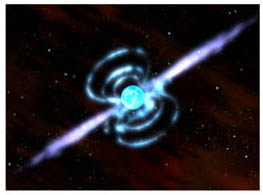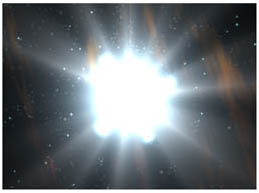CGRO Special Exhibit
Compton's Lingering Mystery: The Unidentified CGRO Sources
Compton has identified hundreds of blazars, gamma-ray bursts and other high-energy phenomena. But, near the end of the mission in Spring 2000, Compton scientists announced the discovery of a new class of mysterious objects.
The known gamma-ray universe contains 170 yet-unidentified high-energy gamma-ray sources, as listed in a 271-source catalog compiled by EGRET. Scientists have struggled for 20 years to associate the unidentified sources with known objects in other wavelengths to no avail.

Left: EGRET Map of all Gamma-ray sources. Right: Map of the unidentified sources. (Credit: NASA/Honeywell Max Q Digital Group, Angela Cheyunski)
Of the 120 unidentified sources in our galaxy (50 unknown are beyond the galaxy), about half lie in a narrow band along the Milky Way plane. These may be well-known classes of objects merely too faint to distinguish in other wavelengths. The other half of the unidentified galactic sources are closer to Earth and make up the new class. These lie just off the Milky Way plane and seemingly follow the Gould Belt, a ribbon of nearby massive stars and gas clouds that winds through the Milky Way plane.
As NASA astrophysicist Neil Gehrels said, "These are objects we've never seen before. We can't make out what they are yet, but we know they're different and, boy, there's a lot of them." Gehrels speculated that the mystery gamma-rays might be from a number of possible sources, all of which are exotic variations on familiar objects.


The magnetic field of a rotating neutron star accelerates particles. This acceleration produces beams of gamma-rays which stream away from the neutron star. When the beam is pointed at earth, we see a bright source of gamma-rays. (Credit: NASA/Honeywell Max Q Digital Group, Dana Berry)
- Black holes with jets of particles shooting away from the black hole and towards us might be visible as gamma-rays. Scientists have observed this phenomenon with EGRET in supermassive black holes, which lurk in the centers of distant galaxies, but never in stellar-size black holes within our galaxy.
- Massive stars, 10-20 times as massive as the Sun, could generate stellar winds that throw high velocity particles into the surrounding space. The particles would slam into gas atoms surrounding the star to produce gamma-rays.
- The Geminga pulsar is one neutron star detectable only in X rays and gamma-rays. A fair fraction of the EGRET unidentified gamma-ray sources could be such exotic high-energy pulsars. Such a discovery would radically change our understanding of pulsars and neutron star populations, as the current census is based largely on only those pulsars detected by radio telescopes.
Scientists who had used CGRO now look to the Fermi Gamma-ray Space Telescope, which launched on June 11, 2008. Fermi has an instrument 30-50 times more sensitive than the EGRET and will continue to work on this mystery.
Published: May 2000
Text Reviewed: September 2018


